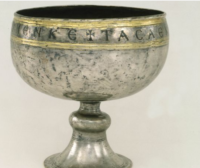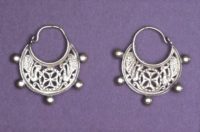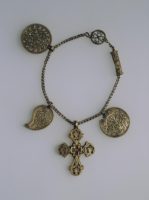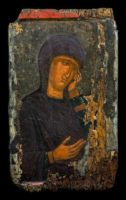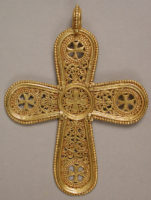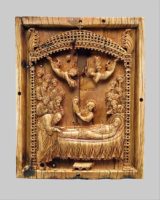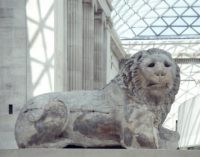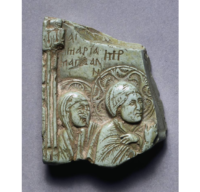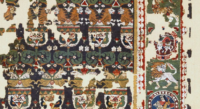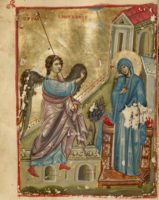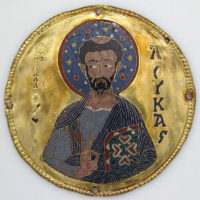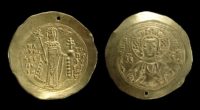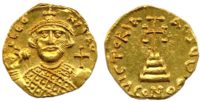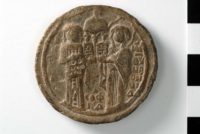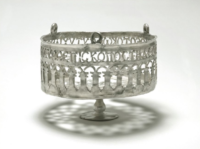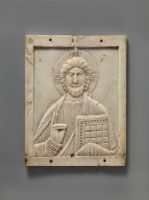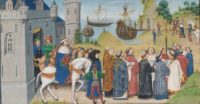Chalice, Period: Early Byzantine, ca. 527 – 565 A.D. Materials: silver and niello. The museum is open to the public Tuesday through Sunday, 11:30 a.m.–5:30 p.m., except for federal holidays.
Pair of Loop Earrings; Materials: Gold. Period: Early Byzantine. 6thC-7thC. Subjects: Cross, Peacock. British Museum is closed 24, 25 and 26 December and 1 January, but is open every other day of the year. Fast facts about the British Museum: Founded: 1753, Collection size: 8 million objects, Oldest object in the collection: Stone chopping tool (nearly 2 million years old).
Necklace, Period: Early Byzantine, circa: 6th century. Made in Constantinople. Material: gold. Technique: carving, engraving. Dimensions: Lenght 27 cm. The collection of the State Hermitage includes over 3 million works of art and world culture artefacts. It contains paintings, graphic works, sculptures, works of applied art, archaeological artefacts and numismatic objects. The Hermitage is considered to have been founded in 1764, when Empress Catherine the Great acquired an impressive collection of works from the Berlin merchant Johann Ernst Gotzkowsky. The museum celebrates the anniversary of its founding each year on 7 December, St. Catherine’s Day. Opening Hours: Tuesday, Thursday, Saturday, Sunday: 10.30-18.00 Wednesday, Friday: 10.30-21.00 Closed: Monday.
Icon of Depicting Virgin Mary Thornousa, which was probably part of a wider composition depicting Extreme Humiliation or Crucifixion. Period: Late Byzantine; circa: The fourth quarter of the 14th century. The shape of the Virgin Mary, with the scattered hair and the deformed by pain characteristics, refers to the expressive, anti-classical flow of Byzantine painting.
Gold Cross Pendant, Period: Early Byzantine, circa: 500–700s. Material: Gold. Dimensions: 3 9/16 x 2 11/16 x 1/2in. (9 x 6.8 x 1.2cm). On view at The Met Fifth Avenue in Gallery 301. The Metropolitan Museum of Art (New York) is one of the world’s largest and finest art museums. Its collection includes more than two million works of art spanning five thousand years of world culture, from prehistory to the present and from every part of the globe. Public Hours: 10:30 a.m.–5:30 p.m. Open seven days a week.
Icon with the Koimesis, Period: Middle Byzantine, circa: late 900s. Made in probably Constantinople. Material: Ivory. On view at The Met Fifth Avenue in Gallery 303. The Metropolitan Museum of Art (New York) is one of the world’s largest and finest art museums. Its collection includes more than two million works of art spanning five thousand years of world culture, from prehistory to the present and from every part of the globe. Public Hours: 10:30 a.m.–5:30 p.m. Open seven days a week.
The Lion of Knidos, Museum Description: Colossal marble statue of a recumbent lion; carved with inlaid eyes originally probably of glass, but now missing. Period: Hellenistic, circa: 2nd century BC. Excavated/Findspot: Knidos, Lion Tomb (Turkey, Aegean Region, Caria, Knidos Ancient City, Anatolia). Materials: marble, glass (eyes). Technique: inlaid (eyes) carved. Dimensions: Length: 2.89 metres Height: 1.82 metres. Location: Not on display (Great Court) Acquisition date: 1859, Discovered by Richard Pullan during Charles Newton’s excavations in 1858; removed by Robert Murdoch Smith; brought back on HMS Supply. British Museum is closed 24, 25 and 26 December and 1 January, but is open every other day of the year. Fast facts about the British Museum: Founded: 1753, Collection size: 8 million objects, Oldest object in the collection: Stone chopping tool (nearly 2 million years old).
[xyz-ihs snippet="British-Museum"]Cameo; opaque red; Period: Late Byzantine circa: 13 thc. Materials: glass. Made in: Venice. The Crucifixion with St John and St Mary and inscription, in relief. British Museum is closed 24, 25 and 26 December and 1 January, but is open every other day of the year. Fast facts about the British Museum: Founded: 1753, Collection size: 8 million objects, Oldest object in the collection: Stone chopping tool (nearly 2 million years old).
Fragment of an Icon of the Crucifixion with Mary Magdalen and the Virgin Mary. Material: Steatite. Period: 14th century, Late Byzantine. The Cleveland Art Museum Hours: Tuesdays, Thursdays, Saturdays, Sundays 10:00 a.m.–5:00 p.m. Wednesdays, Fridays 10:00 a.m.–9:00 p.m. Closed Mondays.
Horse and Lion Hanging, Period: Early Byzantine, 6th century A.D. Materials: wool and linen. The museum is open to the public Tuesday through Sunday, 11:30 a.m.–5:30 p.m., except for federal holidays.
The Annunciation, Manuscript. Period: Late Byzantine, circa: 13th century. Dimensions: Leaf: 20.6 × 14.9 cm (8 1/8 × 5 7/8 in.). Place: Nicaea, Medium: Tempera colors and gold leaf on parchment. (Modern Iznik, Turkey). The J. Paul Getty Museum at the Getty Center in Los Angeles houses European paintings, drawings, sculpture, illuminated manuscripts, decorative arts, and photography from its beginnings to the present, gathered internationally.
Medallion with Saint Luke from an Icon Frame, Period: Middle Byzantine, circa: ca. 1100, Made in Constantinople, Materials: Gold, silver, and enamel worked in cloisonné, Dimensions: Diam: 3 1/4 in. (8.3 cm) Mount: 20 1/2 x 15 x 7/8 in. (52.1 x 38.1 x 2.2 cm), On view at The Met Fifth Avenue in Gallery 303. The Metropolitan Museum of Art (New York) is one of the world’s largest and finest art museums. Its collection includes more than two million works of art spanning five thousand years of world culture, from prehistory to the present and from every part of the globe. Public Hours: 10:30 a.m.–5:30 p.m. Open seven days a week.
Fragment of a Floor Mosaic- Adam and Eve, Period: late 400s-early 500s, Early Byzantium, Northern Syria. The Cleveland Art Museum Hours: Tuesdays, Thursdays, Saturdays, Sundays 10:00 a.m.–5:00 p.m. Wednesdays, Fridays 10:00 a.m.–9:00 p.m. Closed Mondays.
Gold coin; Ruler: Manuel I Comnenus, Byzantine emperor; circa: 1143-1180; Minted in: Constantinople. Weight: 4.484 grammes. British Museum is closed 24, 25 and 26 December and 1 January, but is open every other day of the year. Fast facts about the British Museum: Founded: 1753, Collection size: 8 million objects, Oldest object in the collection: Stone chopping tool (nearly 2 million years old).
Gold coin. Ruler: Leontius II; Period: Early Byzantine; circa: 695-698; Minted in: Rome. British Museum is closed 24, 25 and 26 December and 1 January, but is open every other day of the year. Fast facts about the British Museum: Founded: 1753, Collection size: 8 million objects, Oldest object in the collection: Stone chopping tool (nearly 2 million years old).
Virgin Mary (right) and Emperor Justinian (left), holding between them a model of the church of Hagia Sophia. Period: Middle Byzantine, 12th. century.
The museum is open to the public Tuesday through Sunday, 11:30 a.m.–5:30 p.m., except for federal holidays.
Openwork Lamp with Openwork Inscription, Period: Middle Byzantine, circa Mid. 6th Century A.D. The museum is open to the public Tuesday through Sunday, 11:30 a.m.–5:30 p.m., except for federal holidays.
Icon with Christ Pantokrator, Period: 11th–12th century, Middle Byzantine. Material: Ivory. Dimensions: 3 13/16 x 3 x 3/16 in. (9.7 x 7.6 x 0.4 cm). On view at The Met Fifth Avenue in Gallery 303. The Metropolitan Museum of Art (New York) is one of the world’s largest and finest art museums. Its collection includes more than two million works of art spanning five thousand years of world culture, from prehistory to the present and from every part of the globe. Public Hours: 10:30 a.m.–5:30 p.m. Open seven days a week.
Illuminated Manuscript: The Byzantine Emperor Welcoming Roussillon and Martel. Period: Post Byzantine. Written: 1463 – 1465; Illuminated: 1467 – 1472. Artist/Maker: Loyset Liédet (Flemish, active about 1448 – 1478) and Pol Fruit (Flemish, active about 1468).
Museum Description: “Richly dressed in an ermine-collared cloak and magnificent crown, the Byzantine emperor emerges from the city of Constantinople on a white horse, surrounded by members of his court. A religious procession, including a group of clerics singing from open books, precedes him. The emperor appears again in the background at the right, this time greeting the Europeans who disembark from their boat after their long journey. As the rubric just below the miniature explains, in the 800s Girart de Roussillon and Charles Martel went to assist the Emperor of Constantinople in his battles with the Saracens. When Loyset Liédet painted this miniature in the 1400s, the subject had a special resonance: the recent Turkish capture of Constantinople in 1453 recalled the Saracen incursions and prompted calls for European crusaders to rescue the city.”
The J. Paul Getty Museum at the Getty Center in Los Angeles houses European paintings, drawings, sculpture, illuminated manuscripts, decorative arts, and photography from its beginnings to the present, gathered internationally.
Steelyard Weight with a Bust of a Byzantine Empress and a Hook. This Byzantine steelyard weight dates from the first half of the 5th century. The bronze hook would permit it to be suspended from and moved along a ruled steelyard to determine the weight of an item hung from the opposite end. The Metropolitan Museum of Art (New York) is one of the world’s largest and finest art museums. Its collection includes more than two million works of art spanning five thousand years of world culture, from prehistory to the present and from every part of the globe. Public Hours: 10:30 a.m.–5:30 p.m. Open seven days a week.


